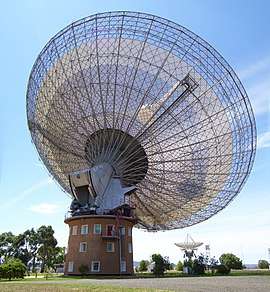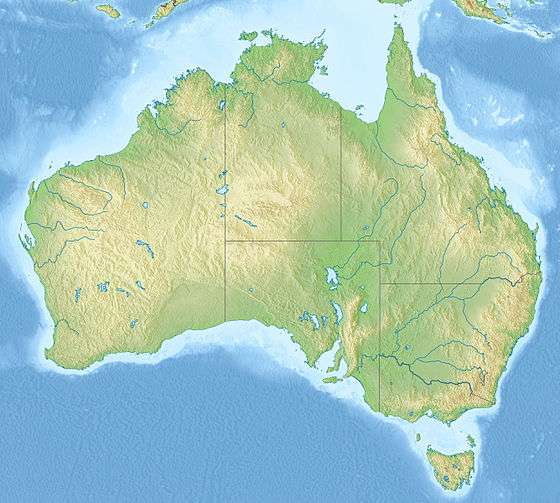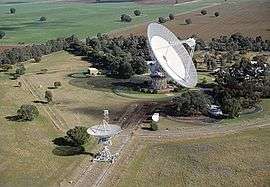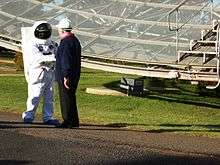Parkes Observatory
The Parkes Observatory (also known informally as "The Dish"[1]) is a radio telescope observatory, located 20 kilometres north of the town of Parkes, New South Wales, Australia. It was one of several radio antennae used to receive live television images of the Apollo 11 Moon landing. Its scientific contributions over the decades led the ABC to describe it as "the most successful scientific instrument ever built in Australia" after 50 years of operation.[1]
 The Parkes 64m Radio Telescope | |
| Organization | CSIRO |
|---|---|
| Location | Parkes, New South Wales, Australia |
| Coordinates | 32°59′52″S 148°15′47″E |
| Website | www |
| Telescopes | Parkes 18-metre telescope Parkes Radio Telescope |
 Location of Parkes Observatory | |
The Parkes Observatory is run by the Commonwealth Scientific and Industrial Research Organisation (CSIRO), as part of the Australia Telescope National Facility (ATNF) network of radio telescopes. It is frequently operated together with other CSIRO radio telescopes, principally the array of six 22-metre (72 ft) dishes at the Australia Telescope Compact Array near Narrabri, and a single 22-metre (72 ft) dish at Mopra (near Coonabarabran), to form a very long baseline interferometry array.
Design and construction
The Parkes Radio Telescope, completed in 1961, was the brainchild of E. G. "Taffy" Bowen, chief of the CSIRO's Radiophysics Laboratory. During the Second World War, he had worked on radar development in the United States and had made connections in its scientific community. Calling on this old boy network, he persuaded two philanthropic organisations, the Carnegie Corporation and the Rockefeller Foundation, to fund half the cost of the telescope. It was this recognition and key financial support from the United States that persuaded Australian prime minister, Robert Menzies, to agree to fund the rest of the project.[2]
The Parkes site was chosen in 1956, as it was accessible, but far enough from Sydney to have clear skies. Additionally the mayor Ces Moon and landowner Australia James Helm were both enthusiastic about the project.[3]
The success of the Parkes telescope led NASA to copy the basic design in their Deep Space Network, with matching 64 m dishes built at Goldstone, California, Madrid, Spain, and Tidbinbilla, near Canberra in Australia.
It continues to be upgraded, and as of 2018 is 10,000 times more sensitive than its initial configuration.[4]
Radio telescope
Hardware

The primary observing instrument is the 64-metre (210 ft) movable dish telescope, second largest in the Southern Hemisphere, and one of the first large movable dishes in the world (DSS-43 'Deep Space Station'-43 at Tidbinbilla was extended from 64-metre (210 ft) to 70-metre (230 ft) in 1987, surpassing Parkes).[5]
The inner part of the dish is solid metal and the outer area a fine metal mesh, creating its distinctive two-tone appearance.
In the early 1970s the outer mesh panels were replaced by perforated aluminium panels. The inner smooth plated surface was upgraded in 1975 which provided focusing capability for centimetre and millimetre length microwaves.[6]
The inner aluminium plating was expanded out to a 55 metres (180 ft) diameter in 2003, improving signals by 1dB.[7]
The telescope has an altazimuth mount. It is guided by a small mock-telescope placed within the structure at the same rotational axes as the dish, but with an equatorial mount. The two are dynamically locked when tracking an astronomical object by a laser guiding system. This primary-secondary approach was designed by Barnes Wallis.
Receivers
The receiving cabin is located at the focus of the parabolic dish, supported by three struts 27 metres (89 ft) above the dish. The cabin contains multiple radio and microwave detectors, which can be switched into the focus beam for different science observations.
These include:[8]
- 1050 cm receiver (Replaced now by UWL)
- The Multibeam Receiver – a 13 horned receiver cooled at −200 °C (−328.0 °F) for the 21 cm Hydrogen line.[9][10]
- H-OH receiver (Replaced now by UWL)
- GALILEO receiver (Replaced now by UWL)
- AT multiband receivers, covering 2.2-2.5,4.5-5.1 and 8.1-8.7 GHz
- METH6, covering 5.9-6.8 GHz
- MARS (X band receiver), covering 8.1-8.5 GHz
- KU-BAND, covering 12–15 GHz
- 13MM (K band receiver), covering 16–26 GHz
- Ultra Wideband Low (UWL) receiver – installed in 2018 it can simultaneously receive signals from 700 MHz to 4 GHz.[11] It is cooled to -255 °C to minimise noise and will enable astronomers to work on more than one project at once.[4][12]
18m 'Kennedy Dish' antenna
The 18-metre (59 ft) 'Kennedy Dish' antenna was transferred from the Fleurs Observatory (where it was part of the Chris Cross Telescope) in 1963. Mounted on rails and powered by a tractor engine to allow the distance between the antenna and the main dish to be easily varied, it was used as an interferometer with the main dish. Phase instability due to an exposed cable meant that its pointing ability was diminished, but it was able to be used for identifying size and brightness distributions. In 1968 it successfully proved that Radio galaxy lobes were not expanding, and in the same era contributed to Hydrogen line and OH investigations. As a stand-alone antenna it was used in studying the Magellanic Stream.[13]
It was used as an uplink antenna in the Apollo program, as the larger Parkes telescope is receive only.[14] It is preserved by the Australia Telescope National Facility.[15]
Australia Telescope National Facility
The observatory is a part of the Australia Telescope National Facility network of radio telescopes. The 64 m dish is frequently operated together with the Australia Telescope Compact Array at Narrabri and a single dish at Mopra, telescopes operated by the University of Tasmania as well as telescopes from New Zealand, South Africa and Asia to form a Very Long Baseline Interferometry (VLBI) array.
Astronomy research

Timeline
1960s
- Built in 1961 and was fully operational by 1963.
- A 1962 series of lunar occultations of the radio source 3C 273 observed by the Parkes Telescope were used to locate the its exact postilion, allowing astronomers to find and study its visual component. Soon to be called "quasi-stellar radio sources" (quasar), Parkes observation was the first time this type of object to be associated with an optical counterpart.[16]
- 1964 to 1966, all-sky survey at 408 MHz of the southern sky is conducted and published (first version of the Parkes Catalogue of Radio Sources) finding over 2000 radio sources including many new quasars.[17]
- Second all-sky survey at 2,700 MHz begins in 1968 (completed in1980).[18]
1990s
- June and November 1990, Parkes collaborates with the Massachusetts Institute of Technology and the National Radio Astronomy Observatory to conduct a 5GHZ (6cm) all-sky survey (The Parkes-MIT-NRAO (PMN) Surveys). The Telescope is equipped with a NRAO multi-beam receiver operating at a frequency of 4850 MHz.[19][20]
- Between 1997 and 2002 it conducted the H I Parkes All Sky Survey (HIPASS) neutral hydrogen survey, the largest blind survey for galaxies in the hydrogen line (21-centimeter line or H I line) to date.
2000s
- More than half of currently known pulsars were discovered by the Parkes Observatory.
- Vital component of the Parkes Pulsar Timing Array[21] programme to detect gravity waves as part of the broader International Pulsar Timing Array (IPTA).
Peryton discovery
In 1998 Parkes telescope began detecting fast radio bursts and similar looking signals named perytons. At the time it was theorised FRBs might be signals from another galaxy, emissions from neutron stars becoming black holes. Perytons were thought to be of terrestrial origin, such as interference from lightning strikes.[22][23][24][25] In 2015 it was determined that perytons were caused by staff members opening the door of the facility's microwave oven during its cycle.[26][27][28] When the microwave oven door was opened, 1.4 GHz microwaves from the magnetron shutdown phase were able to escape.[29] Subsequent tests revealed that a peryton can be generated at 1.4 GHz when a microwave oven door is opened prematurely and the telescope is at an appropriate relative angle.[30]
Breakthrough Listen
The telescope has been contracted to be used in a search for radio signals from extraterrestrial technologies for the heavily funded project Breakthrough Listen.[31][32] The principal role of the Parkes Telescope in the program will be to conduct a survey of the Milky Way galactic plane over 1.2 to 1.5 GHz and a targeted search of approximately 1000 nearby stars over the frequency range 0.7 to 4 GHz.
Historical non-astronomy research

During the Apollo missions to the Moon, the Parkes Observatory was used to relay communication and telemetry signals to NASA, providing coverage for when the Moon was on the Australian side of the Earth.[33]
The telescope also played a role in relaying data from the NASA Galileo mission to Jupiter that required radio-telescope support due to the use of its backup telemetry subsystem as the principal means to relay science data.
The observatory has remained involved in tracking numerous space missions up to the present day, including:
- Mariner 2
- Mariner 4
- Voyager missions (but no longer due to distance of the probes, only the 70 m dish at the CDSCC can still communicate with the two Voyager probes, Voyager 1 and Voyager 2.)[34]
- Giotto
- Galileo
- Cassini-Huygens (until 2017)
The CSIRO has made several documentaries on this observatory, with some of these documentaries being posted to YouTube.[35]
Apollo 11 broadcast
When Buzz Aldrin switched on the TV camera on the Lunar Module, three tracking antennas received the signals simultaneously. They were the 64-metre (210 ft) Goldstone antenna in California, the 26-metre (85 ft) antenna at Honeysuckle Creek near Canberra in Australia, and the 64-metre (210 ft) dish at Parkes.
Since they started the spacewalk early, the Moon was only just above the horizon and below the visibility of the main Parkes receiver. Although they were able to pick up a quality signal from the off axis receiver, the international broadcast alternated between signals from Goldstone and Honeysuckle Creek, the latter of which ultimately broadcast Neil Armstrong's first steps on the Moon worldwide.[36][33]

A little under nine minutes into the broadcast, the Moon rose far enough to be picked by the main antenna and the international broadcast switched to the Parkes signal. The quality of the TV pictures from Parkes was so superior that NASA stayed with Parkes as the source of the TV for the remainder of the 2.5-hour broadcast.[37][33]
In the lead up to the landing wind gusts greater than 100 km/h were hitting the Parkes telescope, and the telescope operated outside safety limits throughout the moonwalk.[33]:300–301
Visitors Centre
The Parkes Observatory Visitors Centre allows visitors to view the dish as it moves. There are exhibits about the history of the telescope, astronomy, and space science, and a 3-D movie theatre.
Legacy
In 1995 the radio telescope was declared a National Engineering Landmark by Engineers Australia.[39] The nomination cited its status as the largest southern hemisphere radio telescope, elegant structure, with features mimicked by later Deep Space Network telescopes, scientific discoveries and social importance through "enhancing [Australia's] image as a technologically advanced nation".[40]
On Monday, 31 October 2011, Google Australia replaced its logo with a Google Doodle in honour of Parkes Observatory's 50th anniversary.[41]
In popular culture
- In 1964 the telescope featured in the iconic opening credit sequence of The Stranger Australia's first locally produced sci-fi TV series. Some scenes were also shot on location at the telescope and inside the observatory.[42]
- The observatory and telescope were featured in the 2000 film The Dish, a fictionalised account of the observatory's involvement with the Apollo 11 Moon landing.[43]
- The telescope is featured on the cover of Steve Hillage's 1977 album Motivation Radio.
References
- Robertson, Peter (9 February 2010). "40 Years of The Dish". ABC Science. ABC. Archived from the original on 15 July 2014. Retrieved 16 June 2014.
- Robertson, Peter. "40 Years of The Dish". Australian Broadcasting Corporation. Archived from the original on 7 March 2007. Retrieved 10 February 2007.
- "Parkes radio telescope construction". CSIROpedia. Archived from the original on 15 July 2019. Retrieved 15 July 2019.
- Little, Christine (15 May 2018). "Multi-million dollar receiver to revolutionise science at Parkes Radio Telescope". Parkes Champion Post. Archived from the original on 17 July 2019. Retrieved 17 July 2019.
- "Canberra Deep Space Communication Complex". NASA Jet Propulsion Laboratory. Archived from the original on 7 August 2011.
- Leverington, David (2017). Observatories and Telescopes of Modern Times (PDF). Cambridge University Press. p. 285. ISBN 978-0-521-89993-2. LCCN 2016026406. Archived (PDF) from the original on 17 July 2019. Retrieved 17 July 2019.
- "CSIRO's Parkes Telescope Surface Upgrade March 2003". Australia Telescope National Facility. Archived from the original on 5 April 2019. Retrieved 15 July 2019.
- "Receivers and Correlators". Australia Telescope National Facility. Archived from the original on 19 March 2019. Retrieved 17 July 2019.
- Lomb, Nick (25 September 2012). "The Parkes Multibeam Receiver mapped galaxies over the entire southern sky". Museum of Applied Arts & Sciences. Archived from the original on 17 July 2019. Retrieved 17 July 2019.
- Staveley-Smith, Lister (27 May 1997). "Multibeam Receiver Description". Australia Telescope National Facility. Archived from the original on 19 March 2019. Retrieved 17 July 2019.
- "Parkes radio-telescope gets an upgrade". Cosmos Magazine Blog. 21 May 2018. Archived from the original on 15 July 2019. Retrieved 15 July 2019.
- "Ultra wideband receiver at Parkes". Australia Telescope National Facility. Archived from the original on 23 March 2019. Retrieved 17 July 2019.
- Orchiston, Wayne (July 2012). "The Parkes 18-m Antenna: a brief historical evaluation". Journal of Astronomical History and Heritage. 15 (2): 96–99. Bibcode:2012JAHH...15...96O.
- Kent German (13 December 2011). "Down Under, 'the dish' looks to the heavens (photos): Both big and small". cnet. Archived from the original on 16 July 2019. Retrieved 16 July 2019.
- Wayne Orchiston, ed. (2005). The New Astronomy: Opening the Electromagnetic Window and Expanding Our View of Planet Earth. Springer. p. 163. ISBN 1-4020-3724-4.
- Parkes and 3C273, The Identification of the First Quasar , parkes.atnf.csiro.au
- Colin Ward, Parkes radio telescope construction, Achievements, Parkes radio telescope, construction, csiropedia.csiro.au, 2011
- Colin Ward, Parkes radio telescope construction, Achievements, Parkes radio telescope, construction, csiropedia.csiro.au, 2011
- Colin Ward, Parkes radio telescope construction, Achievements, Parkes radio telescope, construction, csiropedia.csiro.au, 2011
- The Parkes-MIT-NRAO (PMN) Surveys, The Parkes 64m radio telescope is located in Parkes, New South Wales, virtualobservatory.org
- "Parkes Pulsar Timing Array". Australia Telescope National Facility Wiki. Archived from the original on 5 July 2016. Retrieved 10 August 2016.
- Pearlman, Jonathan (5 May 2015). "Strange 'outer space' signal that baffled Australian scientists turns out to be microwave oven". The Telegraph. Archived from the original on 16 February 2018. Retrieved 4 April 2018.
- Monica Tan. "Microwave oven to blame for mystery signal that left astronomers stumped". The Guardian. Archived from the original on 3 March 2017. Retrieved 16 December 2016.
- Heisler, Yoni (5 May 2015). "Parkes Telescope's mysterious radio signals didn't come from aliens, but from a microwave - BGR". BGR. Archived from the original on 7 May 2015. Retrieved 7 May 2015.
- George, Honey (6 May 2015). "Parkes Telescope Scientists Found That The Outer Space Signals Were Not From Aliens But From Their Microwave Oven". International Business Times. Retrieved 7 May 2015.
- "Parkes telescope scientists discover 'strange signals' from kitchen microwave". ABC News. Archived from the original on 7 May 2015. Retrieved 7 May 2015.
- "Microwave oven baffled astronomers for decades". Wired UK. Archived from the original on 19 May 2016. Retrieved 7 September 2017.
- "Parkes telescope scientists discover strange 'space signals' actually came from kitchen microwave". MSN. 5 May 2015. Archived from the original on 8 May 2015. Retrieved 7 May 2015.
- "Astronomy mystery solved: They're space pings, but not as we know them". The Sydney Morning Herald. Archived from the original on 6 May 2015. Retrieved 7 May 2015.
- Petroff, E.; Keane, E. F.; Barr, E. D.; Reynolds, J. E.; Sarkissian, J.; Edwards, P. G.; Stevens, J.; Brem, C.; Jameson, A.; Burke-Spolaor, S.; Johnston, S.; Bhat, N. D. R.; Chandra, P.; Kudale, S.; Bhandari, S. (2015). "Identifying the source of perytons at the Parkes radio telescope". Monthly Notices of the Royal Astronomical Society. 451 (4): 3933. arXiv:1504.02165. Bibcode:2015MNRAS.451.3933P. doi:10.1093/mnras/stv1242.
- Zhang, Sarah (20 July 2015). "A Russian Tycoon Is Spending $100 Million to Hunt for Aliens". WIRED. Archived from the original on 13 April 2016.
- "Stephen Hawking's $135m search for alien life: Parkes telescope in NSW to lead way". NewsComAu. 12 August 2015. Archived from the original on 18 October 2015. Retrieved 23 October 2015.
- Sarkissian, John (2001). "On Eagles Wings: The Parkes Observatory's Support of the Apollo 11 Mission" (PDF). Publications of the Astronomical Society of Australia. 18 (3): 287–310. Bibcode:2001PASA...18..287S. doi:10.1071/AS01038. Archived (PDF) from the original on 2 April 2019. Retrieved 15 July 2019.
- "Life of a Universe". Australian Broadcasting Corporation. Archived from the original on 12 March 2017. Retrieved 23 March 2017.
- "CSIRO YouTube Channel". Archived from the original on 20 December 2016. Retrieved 26 November 2016.
- Andrew Tink (15 July 2019). "Honeysuckle Creek: the little-known heroes of the Moon walk broadcast". Australian Geographic. Archived from the original on 15 July 2019. Retrieved 15 July 2019.
- Falk, Dan (9 July 2019). "A Wind Storm in Australia Nearly Interrupted the Moon Landing Broadcast". Smithsonian Magazine. Archived from the original on 14 July 2019. Retrieved 14 July 2019.
- "Mars Exploration Rover Mission: All Opportunity Updates". NASA Jet Propulsion Laboratory. Archived from the original on 12 August 2012. Retrieved 14 August 2012.
- "Radio Telescope, Parkes, 1961-". Engineers Australia. Archived from the original on 14 September 2016. Retrieved 9 September 2016.
- "Submission to the Institution of Engineers, Australia to nominate the Parkes Radio Telescope as a National Engineering Landmark" (PDF). Engineers Australia. 15 October 1995.
- Kidman, Alex (31 October 2011). "Google Doodle Celebrates Parkes Observatory". Gizmodo. Archived from the original on 5 November 2011. Retrieved 13 November 2011.
- Maguire, Dannielle (2 February 2020). "The Stranger, Australia's answer to Doctor Who, premieres on ABC iview after decades in the vaults". ABC. Retrieved 11 February 2020.
- Barkham, Patrick (25 May 2001). "Dishing up an Australian legend". The Guardian. Retrieved 1 October 2018.
External links
| Wikimedia Commons has media related to Parkes Observatory. |
- Official website
- Parkes Observatory Visitors Centre
- A Tour of the Parkes Radio Telescope (1979)
- ABC Science, 2001: 40 years of the Dish
- View the dish in action
- Observation of Mariner IV with the Parkes 210-ft Radio Telescope
- The sound of the Universe singing - ABC Radio National radio documentary on the story of 'the dish' since its construction
- Parkes Pulsar Timing Array